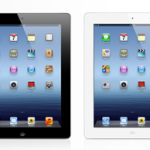 2012 was an outstanding year for real estate technology embracing mobile. 2013 will be even better. However, all of this new freedom functionality will be for naught if agents do not buy iPads.
2012 was an outstanding year for real estate technology embracing mobile. 2013 will be even better. However, all of this new freedom functionality will be for naught if agents do not buy iPads.
In November, WAV Group did a number of research projects that included information about the adoption of mobile in real estate. By our average numbers, 60% of agents now have a smartphone. 40% of agents have a tablet computer like an iPad. We would have served ourselves well to break out the types of devices that agents use by sorting Apple devices from Android devices, but we did not.
Lots of people talk about cloud computing. The notion is that all applications and data are in the cloud, accessible from any device that can reach the Internet. Unfortunately, this is not exactly the case. As WAV Group has long bemoaned, the cornerstone of agent technology is the MLS, and many MLS systems have been slow to fully support Apple desktop and mobile devices. It is the number 1 complaint in agent satisfaction surveys.
Sure, there are tools to work around it, but at the end of the day, many MLS systems are not fully functional on mobile. Alas, things are looking up. Most MLS systems are now cross-browser compatible or will be in Q1. In many ways, secondary applications like agent website administration, CRM, CMA, and Marketing solutions are ahead of MLSs at going mobile.
All things considered, the industry is moving in the direction of supporting mobility, but 40% adoption rates for tablets undermine the marketplace. Many think that 40% adoption is great, others see it as lack luster. It is all about perspective. The single piece of advice that I would give to an agent to prepare for 2013 is to get a tablet (preferably an iPad), and learn how to use it.
Brokers missed a huge opportunity up until now. Rather than complain about the MLS’s failure to support Apple and Mobile, they could have delivered end-to-end solutions that enabled the agent to skip the MLS entirely, and rely on the broker for all things in serving the client. To effectively do this, the broker would have needed to insist that administrators manage listing input and modifications. This is still a very wise and practical strategy. If you are a great broker, you have listing input in the broker solutions that you provide to your agents to power your listing presentations anyway. Sadly, few of these solutions are mobile enabled for listing input. My understanding is that most large broker solutions providers are focused on this right now.
Up until now, mobilizing real estate applications has been focused on listing data. 2013 will be focused on mobilizing client record data, and synchronizing the client record across all applications.
Here are a couple of examples:
If a customer saves a listing to favorites on your website, that listing will also be saved to favorites on your mobile application, and vice versa. The customer record will be transportable into other applications. A listing saved to favorites will dynamically create a buyer CMA, a mortgage quote, an insurance quote, and home warranty options. It will be effortless.
A listing agreement will queue up marketing events like a photo shoot, virtual tour, flyers, print advertising, online advertising, open house scheduling, home inspection and so forth.
Today, all of these individual steps using multiple software applications (many of which can only be used on a desktop) cause significant loss of productivity with agents. The solutions exist, but even one application that causes the agent to use a desktop will undermine mobile productivity, especially if any type of data entry is duplicated. Agents should only need to enter listing and client information one time, and that information should be available in every application within 15 minutes on any device.
Take time this week to list every piece of software that you use in your MLS or Brokerage.




